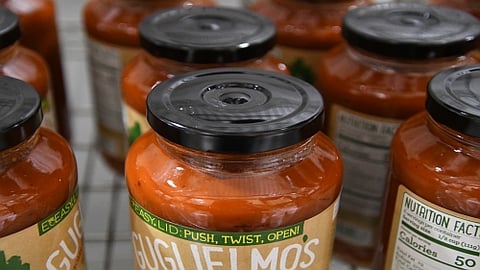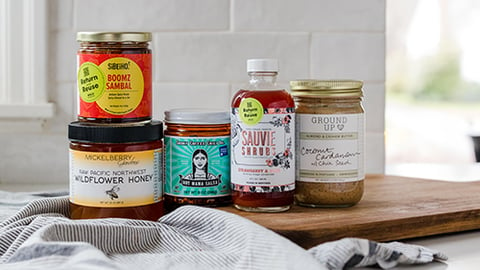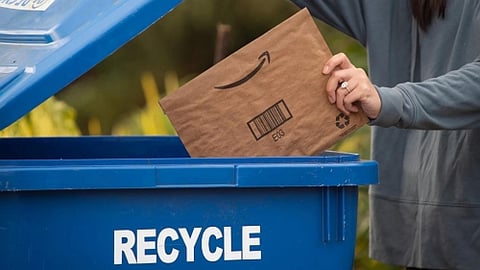Grocers Are Raising the Bar on Takeout Packaging
Supermarkets are bidding farewell to leaky takeout soup containers with typed adhesive labels. Not only is this generic packaging messy and unaesthetic, it also doesn’t show contents or highlight ingredients. Additionally, these containers may not survive the microwave or freezer. And they make soup look like the least appetizing food in the fresh prepared food department. While other items in the department may look a bit more enticing, their traditional packaging also leaves much to be desired.
Grocers have been raising the bar on prepared food packaging, however. Rather than generic containers, they’re using vessels with custom pre-printed labels that highlight attributes and make branded statements. Packaging has become leak- and tamper-proof, affording more safety and stability during transport. Many items can be reheated in the same container. And more containers are biodegradable or appropriate for curbside recycling programs.
[Read more: "How Consumers Are Driving Packaging Changes"]
“Packaging plays a significant role and has come a long way in terms of technology,” says Irma Randles, marketing manager, fresh food to go at ProAmpac, in Cincinnati. “Consumers shop with their eyes. Packaging is sometimes an afterthought. But the right packaging has an impact on overall food quality.”
Jonna Parker, team lead for fresh at Chicago-based Circana (formerly IRI), notes that the prepared food section has transformed itself more dramatically than any other area.
“This department has changed how food is reaching consumers’ carts,” adds Parker. “Retailers can be more standardized and creative. They can communicate with visuals on packaging or heating instructions. They can make a brand family. When you just had that white label with a code, you couldn’t communicate well.”
Changes result from ongoing, unprecedented prepared food growth in supermarkets. According to Circana, sales of fresh prepared foods totaled more than $21 billion for the calendar year ended Jan. 1, 2022, an 18.8% increase over the previous year. For the calendar year ended Jan. 1, 2023, sales increased an additional 12%. Fastest-growing categories included combo meals, entrées, pizza, prepared meats, salads, sandwiches, soups and chili.
Growth — along with packaging innovation — has been driven largely by COVID-19 restrictions on restaurant dining, which prompted shoppers to seek more prepared food options and made the category more competitive. Consumers have since become more familiar with prepared grocery food and continue purchasing it.
“COVID was the tipping point, due to high demand,” affirms Rafael Posada, global sustainability director at Wayne, Pa.-based TekniPlex Consumer Products. “This food was there before COVID, but COVID made issues important. When COVID started, most deli-area packages weren’t designed for the logistics and mass production COVID demanded. With restaurants closed, consumers became better educated, demanding higher quality.”
Today, rampant inflation has again curtailed restaurant dining in favor of lower-priced supermarket fare. According to restaurant software provider HungerRush, 50% of Americans are dining out less frequently.
Labor and space issues have made it challenging for some grocers to meet demand. These circumstances have prompted many to pre-package food on-site or, more often, through a third party, according to Parker. This has further facilitated the use of better packaging.
“In 2018, only 41% of deli prepared foods were sold in fixed-weight packages,” she observes. “Since [that time], share of pre-packaged fixed-weight packaging has grown 11 share points. These are massive changes.”
Packaging Criteria
Regardless of where food is packaged, it must now meet key criteria driven by increasingly demanding consumers. Following are the most significant requirements.
Safety and transportability: COVID-19 drove growth of Uber Eats and other food delivery services. Containers must now be leak-proof and tamper-resistant for handling during delivery. “People don’t want things popping open and want to know it hasn’t been opened by someone,” asserts Krista Anderson, assistant program and category manager, prepared foods at Portland, Ore.-based New Seasons Market.
In 2022, Shelton, Conn.-based InLine Plastics added tamper-proof containers for hot foods under the Safe-T-Chef line. “There were no tamper-evident options for hot food,” says Carrie Cline, senior brand manager. “For traveling foods that change hands multiple times, consumers want security.”
Products are crystal-clear polypropylene and come in a dozen shapes and sizes. They provide security without using a wraparound label that would hide contents. Rigid sides prevent leakage. Multiple compartments keep foods separate, with sealed sections for dips and dressings. InLine’s Safe-T-Chef, along with its Safe-T-Fresh assortment, offers “over 100 options,” according to Cline.
Freshness has always been important for taste and food safety, but newer technologies have improved on that. ProAmpac, for example, uses special barriers in the film lining its packaging, forming a moisture barrier. “Foods last anywhere from a few days to weeks,” says Randles.
Appearance: Branding has become more important, whether it’s the grocer’s own brand or an outside supplier’s, as a way to make products quickly recognizable. New Seasons’ soups are packaged by an outside party, with custom labels designed by a marketing team. “It’s definitely more branded,” notes Anderson. “Packaging influences buying decisions. It’s important that grab-and-go customers in particular see food.”
InLine’s clear polypropylene and PET packaging accomplish visual goals, since consumers can see the food’s quality and freshness. “Food must look fresh and appealing to eat,” says Cline.
TekniPlex changed packaging from what were once “generic” offerings to products that are all clear and resistant to condensation. “It makes chicken look more appealing,” notes Posada.
ProAmpac offers fiber-based packaging, an alternative to plastic that lets design elements and information be printed directly on containers. “There’s no need for additional printed labels,” says Randles. “It’s more streamlined and creates a more impactful destination without a display of rigid plastic containers.” The packaging’s plastic windows facilitate viewing.
Whitney Atkins, VP of marketing at the Madison, Wis.-based International Dairy Deli Bakery Association, cites the importance of mentioning foods’ benefits on labels. “Highlight important ingredients, nutrients and production attributes like organic, non-GMO and gluten-free,” she says. “Focus on benefits like high delivery of vitamin D and immune support. QR codes can help extend limited on-package space for further information.”
Convenience: New Seasons uses oven-safe and microwavable containers for holiday offerings like mashed potatoes and stuffing. “Customers appreciate it,” observes Anderson. “Lids on foil containers could melt. We look for versatile packaging. It might have a clear lid, with the rest being black. But if it’s microwaveable, it may outweigh that fact that it’s not all transparent.”
The importance of microwaveability prompted TekniPlex to develop polypropylene containers with this functionality. “It’s become more relevant,” adds Posada.
Product specificity: New Seasons replaced a branded bag with a plastic clamshell that maintains the temperature of rotisserie chickens. In addition to being convenient for shoppers, chickens stay at a safe temperature so they don’t have to be discarded if unsold that day. “Rather than go in the trash, we reuse them in soup or salad,” explains Anderson.
With sushi, New Seasons uses a customized clear poké bowl that makes all layers visible. “If it had a black plastic bottom, you’d hardly see anything,” adds Anderson. “It’s attractive food you must show off.”
For his part, Posada notes that more retailers are “specializing” with sushi packaging, which “used to be a stock item.”
Sustainability: The importance of sustainability is growing. ProAmpac’s fiber-based packaging is fully recyclable once the clear window is removed. While this type of packaging can be more costly, it’s also lighter, affording more transportation savings from both weight and volume perspectives. “You can fit much more in a truck load or pallet,” says Randles.
InLine’s PET products contain 10% post-consumer content, according to Cline. Its clear containers, namely hot food ones, are fully recyclable. “Hot foods have traditionally been packaged using a black-based component,” she continues. “They’re challenging to sort at materials recovery facilities and end up in landfills.”
New Seasons is serious about sustainability. The grocer sources plastic that’s 100% post-consumer recycled. In-store eating areas let consumers dispose of food items responsibly, according to Anderson. Additionally, the company tries to educate shoppers about sustainability. “Our huge passion for sustainability guides much purchasing,” she adds.
Supermarkets’ growing roster of packaging demands sometimes challenges the industry in that adding certain packaging attributes can compromise others. “Finding the right balance between sustainability, convenience and safety is the biggest and most on-trend challenge,” admits Cline.
There has never been a better time to be in the prepared food packaging industry, however.










